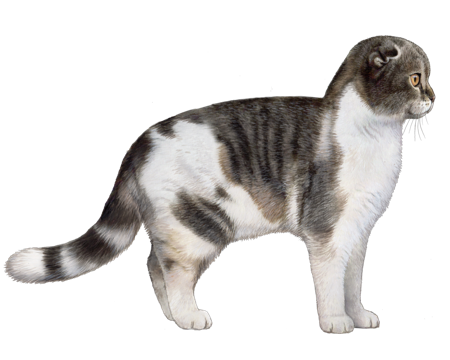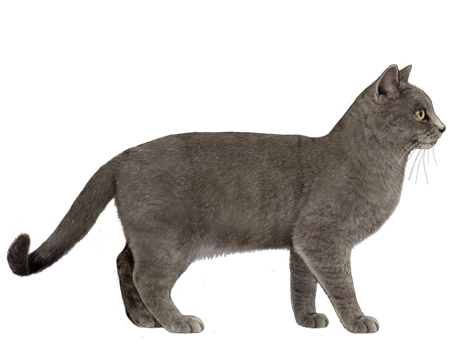
Persian
Persians are sweet, adaptable cats known for their flat faces and large, round eyes. This low-key, gentle breed gets along with everybody and makes a great addition to calm households.
Interested in discovering if your cat is a Persian?
Check out Wisdom Panel's DNA test.
Persian Traits
General Appearance
Persians are medium-to-large cats with heavily boned, muscular bodies. They're famous for their overall round appearances, flat faces, and intelligent expressions.
Coat and Colouring
The Persian's coat is long, thick, and soft. These cats have a frill that covers their shoulders and chest—extending between their front legs—and long tufts of hair between their toes and inside their ears. Their tails are short with bushy fur.
Persians come in various coat colors and patterns, including solid colors, colorpoint, shaded, tortoiseshell, and tabby.
Distinctive Physical Traits
Persians are known for their short, snub noses, large, round heads, and small, round-tipped ears. Their big eyes come in various colors (depending on their coat color) and give them a sweet expression.
These cats have broad, muscular bodies, short, thick legs, and large, round paws. Their tails are short in proportion to their body and slightly rounded at the tip.
Did we mention they are round?
Persian Temperament
Persians are sweet cats that generally make easy-going housemates. Because of their quiet, gentle nature, this breed is best suited for calm indoor environments. Though they enjoy being petted by kids, they're not the kind of cat that likes rough-housing.
This breed is just as content to play with cat toys as lounge around on a comfy piece of furniture. Though Persians are happy when their humans return home after a day at work or school, they don't mind spending time in the house alone, either. They're also not overly demanding cats. But when they want to make their needs known, they're more likely to communicate with their big, expressive eyes than their soft, musical voices.
You'll rarely find a Persian perched high on a cabinet, as these cats prefer the safety of being close to the ground.
Persian History
Persians are one of the oldest—not to mention most recognizable—cat breeds in the world. Like many ancient breeds, their exact origin is unclear. But hieroglyphic references to cats like Persians date back to 1684 B.C.
Historical records from the 17th century mention longhaired cats in Turkey and Persia. And experts believe that, in the 19th century, breeders crossed descendants of these longhaired Turkish cats with Italian longhaired cats to create the modern Persian.
Persian cats rose to fame when Britain featured them in their first cat shows, and the breed captured the hearts of Queen Victoria and other royals. At the end of the 19th century, Persians arrived in the United States—where they became (and still are) wildly popular.
Persian Care
Nutrition
Persians require a high-quality diet formulated for their age and activity level. Consider foods that address their breed-specific nutritional needs. For example, Persian diets often contain nutrients that promote shiny coats or kibble shapes designed for the breed's short jaw.
Persians aren't the most active cat breed. So, it's important to keep their calories in check to prevent obesity. Avoid overfeeding by carefully measuring your cat's food with a standard measuring cup. And remember, treats should contribute to no more than 10% of their daily calories.
In addition to meals, make sure your cat has access to clean water at all times. Some Persian cats prefer to drink out of water fountains, which keeps the plentiful fur on their chests drier.
Grooming
A Persian's grooming needs depend on their coat variety. Cats with silky coats require less maintenance than those with soft textures, which tend to stain and mat more easily. But no matter the coat type, all Persians need daily brushing to prevent tangles and remove loose hair—which, left unattended, can result in hairballs.
Persians also benefit from occasional baths. But don't worry. Once they get used to it, they typically enjoy a good bath. In addition to cleaning your cat's coat, wipe their eyes daily to remove dust or other irritants that can lead to runny eyes.
Finally, round out their grooming routine with regular nail trims, at-home teeth brushing, and professional dental cleanings.
Health
Persians are a brachycephalic breed. That means they have physical features—such as a flat face, short nose, and wide skull—that may cause health issues. Potential challenges include breathing difficulties, heat sensitivity, jaw deformities that lead to dental disease, trouble eating or drinking, and skin or eye issues.
Persians may also be more prone to developing Hypertrophic Cardiomyopathy. This condition decreases the heart's efficiency and can lead to other issues. Talk with your veterinarian about ways you can manage or minimize the health risks of your Persian cat.
Persian Genetic Health Conditions
-
Chediak-Higashi Syndrome (Discovered in the Persian)
Chediak-Higashi Syndrome (CHS) is a metabolic disorder that causes partial albinism, prolonged bleeding, sensitivity to light and cataracts to develop at a young age.
-
Factor XII Deficiency (Variant 1)
Factor XII Deficiency, also known as Hageman trait, is an asymptomatic blood factor deficiency. While it does not cause an abnormal tendency to bleed, it can be observed as prolonged blood clotting times during certain laboratory screening tests.
-
Factor XII Deficiency (Variant 2)
Factor XII Deficiency, also known as Hageman trait, is an asymptomatic blood factor deficiency. While it does not cause an abnormal tendency to bleed, it can be observed as prolonged blood clotting times during certain laboratory screening tests.
-
Polycystic Kidney Disease (PKD)
Polycystic Kidney Disease (PKD) is the most common inherited disease in cats. The disease causes the formation of fluid-filled cysts in the kidneys that can lead to kidney failure.
-
Progressive Retinal Atrophy (Discovered in the Persian)
Progressive Retinal Atrophy (Discovered in the Persian) is a disorder that causes degeneration of the light sensing retina at the back of the eye, resulting in vision loss.
With more than 45 health tests, Wisdom Panel™ Complete for Cats screens for these and other important genetic conditions—allowing you to better plan for your cat's lifelong care.
Breed Group
Persian
An ever-popular variety, the breeds within this group tend to share a common genetic connection with Persian cats.
Resources
https://tica.org/breeds/browse-all-breeds?view=article&id=1416:persian-breed-of-the-week&catid=48
https://tica.org/breeds/browse-all-breeds?view=article&id=864:persian-breed&catid=79
https://www.royalcanin.com/us/cats/breeds/breed-library/persian
https://www.gccfcats.org/Cat-Breeds/Persian
http://www1.fifeweb.org/dnld/std/EXO-PER.pdf
https://www.royalcanin.com/us/cats/products/retail-products/persian-adult-dry-cat-food
Reviewed 23 February 2021 by Annette Louviere, DVM
















